Richard Lubbock facts for kids

Richard Lubbock (born around 1759, died 1808) was an English doctor and scientist. He was very interested in chemistry. He wrote about an old idea called the phlogiston theory in his 1784 paper. This paper was based on what his teacher, Joseph Black, taught him.
Contents
Life and Work
Richard Lubbock was born in Norwich, England. He went to the Grammar School there. Later, he studied at the University of Edinburgh. After finishing his studies, he came back to Norwich. He worked as a doctor at the Norfolk and Norwich Hospital.
Lubbock was a respected doctor. He wrote important papers about different health topics. These included diabetes, a condition where the body has trouble with sugar. He also wrote about catalepsy, a state where someone becomes stiff and unresponsive. His work also covered apoplexy (like a stroke) and vaccination.
His Family
Richard Lubbock had two sons who also became notable. His son, Reverend Richard Lubbock, became a church leader in Eccles. He was famous for studying the natural world of the Norfolk Broads. This area is known for its beautiful lakes and rivers. Another son, Edward, also followed in his father's footsteps and became a doctor.
Exploring Chemical Ideas
One of Lubbock's most important works was his 1784 science paper. In this paper, he looked closely at the phlogiston theory. This was a popular idea at the time about how things burn.
What was Phlogiston Theory?
The phlogiston theory was an old idea. It said that when something burned, it lost a special substance called "phlogiston." For example, if wood burned, it released phlogiston into the air.
However, at the time Lubbock was writing, new ideas were appearing. His teacher, Joseph Black, was starting to doubt phlogiston theory. Another scientist, Antoine Lavoisier, was developing a new theory. Lavoisier's idea was that burning involved a substance called oxygen, not phlogiston.
Lubbock's Experiments
Lubbock did his own experiments. He wanted to see if the phlogiston theory was correct. He also wanted to test the newer ideas. He showed how some old ideas could be proven wrong by experiments.
Lubbock thought that when something burned, it reacted with air. This reaction would create a new substance. It would also release light and heat. He used the term "pure air" for what we now call oxygen. He noticed that this "pure air" combined with things like sulfur, charcoal, and phosphorus. When they combined, they released heat and light. He also saw that the air lost some of its volume during this process.
New Ways of Thinking
Lubbock also looked at how chemicals combine. He thought about different ways substances could join together or swap parts. He used terms like "Attractio duplex" (where two compounds swap parts) and "Attractio simplex" (where one substance joins a compound and pushes out another part). These ideas helped him understand chemical reactions better.
He noted that his teacher, Joseph Black, was teaching phlogiston theory. But Black was starting to lose faith in it. Lubbock's paper even suggested that Black had given up on the idea by 1784. This was earlier than many people thought.
Lubbock's Theory of Burning
In the end, Lubbock developed his own ideas about burning. He believed:
- "Pure air" (oxygen) was a key part of burning.
- Heat and light were released during burning.
- Things that burn (like phosphorus or charcoal) combine with "pure air."
- They do not lose any special substance like phlogiston.
- Heat comes from the sun and has no weight.
- Water is made of "pure air" and another gas.
- Breathing, fermentation, and decay also use "pure air" from the air.
- Acids and alkalis (calces) are also made with "pure air."
Lubbock's ideas were important. They helped spread new ways of thinking about chemistry across Europe.

